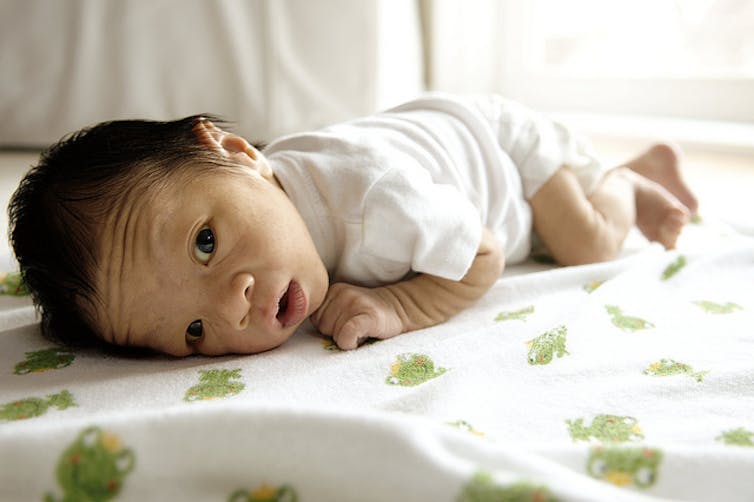4 Month Old Baby Head Flat on One Side
Apartment head syndrome, also called positional plagiocephaly, develops in babies considering of external pressures on the soft, malleable infant skull. It is more mutual now that babies sleep on their backs, as recommended by SIDS rubber guidelines.
While one in five children are affected by flat head syndrome, parents receive mixed letters about whether it has an impact on development, and clinicians don't have skilful evidence to allay fears.
Our review published this week shows that while not all children displaying a flat head will experience developmental problems, the syndrome can be used as a mark of potential developmental filibuster. We make the recommendation that children with flat head be assessed for developmental delays.
What is flat head syndrome and why does it develop?
Flat caput syndrome presents as a flattened area on the back or side of a baby'due south head. In severe cases information technology can touch the alignment of the ears, eyes and jaw. It's typically noticed by the parent up to the fourth calendar month of age. Information technology can exist present at birth or develop over time, upward to almost the 18 month mark when the baby'due south skull bones are harder and stock-still in identify.
The syndrome develops because of external pressures to the soft, malleable babe skull. Information technology'southward become more common since 1992, when the SIDS safety sleeping campaign Back to Slumber (now known as Safe to Slumber) began. This campaign saved lives, and continues to exercise so.
With the need for rigorous information on whether flat head syndrome leads to developmental delay, we reviewed existing medical literature to inform clinicians and parents on the state of cognition in this surface area. At that place were 19 studies that met our strict quality criteria, in which the children's ages ranged from three months to 10 years.
Identifying risk
Our review shows flat caput syndrome is a marker of developmental filibuster. Delay can occur in one or multiple areas of development known as domains. For children with apartment head, delays were observed virtually commonly in the motor domain, decision-making muscular activities such as walking (gross motor) and holding a spoon (fine motor). The second and tertiary nigh common delays were observed in language and cognition (such as speaking or understanding one's own name).
Although nosotros sought to address whether flat caput leads to delays, or whether delays are causing flat head, none of the studies conducted to date are able to answer this question. Thus, given there is a link, but the direction is to be determined, we make the recommendation that children with flat caput be assessed for developmental delays.
Simple developmental milestones should be met (within the normal variation). When non met, clinicians (GPs, physiotherapists, occupational therapists, nurses) tin use standardised assessment tools to more objectively assess the kid's development and refer for early intervention if necessary.
Our review found children with flat caput who had developmental delays on multiple domains (such as motor, learning and cognition), or who had low muscle tone, were a special high risk group where intervention and longer-term follow-upwards would likely exist helpful.
Our review found delays were more common in newborn to ii-yr-olds, merely delays did persist to preschool and school aged children in some cases, although at that place is less knowledge on the older age groups.

Most children with flat caput syndrome will exist fine
While it is hard to say with confidence what proportion of children with flat head will experience a developmental delay, it is likely most children with flat head will exist fine in terms of their development.
In the studies included in the review, about 10-25% of the children had developmental delays across that expected (although the range observed was three-51% depending on the report). Some studies presented this in terms of take a chance, and reported children with flat head were up to 10 times more likely to experience developmental delays than children without flat head.
How parents tin can forbid or reduce flat caput
The benefits of following the SIDS guidelines far outweigh whatever concerns about flat head, given death could result from not following condom sleeping recommendations. Babies should exist put to sleep on their backs in a business firm, flat area, complimentary of toys, pillows or other items, in a not-smoking environment.
Home prevention of flat caput syndrome is possible. Tummy time while awake and supervised – a little flake every day starting from birth – can help strengthen neck muscles, and provide time off the back and sides of the head. Altering the position of baby while awake (holding, or in a carrier) is as well helpful.
Some children are at heightened gamble of flat caput syndrome, such every bit premature babies, those with a challenging nascence, or who accept torticollis (as well known every bit wry or twisted cervix), and so y'all should not experience guilty if your child has a apartment head. If concerned at any time, you should seek communication from a health professional. Since babies receive vaccinations at several time points during their first year this tin can be an opportune time to seek assessment and communication.
Source: https://theconversation.com/do-you-need-to-worry-if-your-baby-has-a-flat-head-71794
0 Response to "4 Month Old Baby Head Flat on One Side"
Postar um comentário